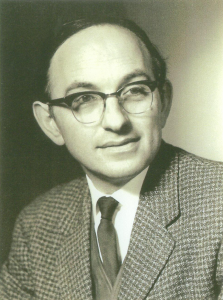Irving J. Good (1916–2009)
 Irving J. Good was born in London in 1916 and became proficient in mental arithmetic by the age of nine. Lying in bed with diphtheria, he turned over in his mind his sister’s lesson on square roots. On his own, he realized the irrationality of the square root of two and solved Pell’s equation. The impressive feat of reaching these conclusions as a young boy is not compromised by the fact that they had been reached by others long before he was born.
Irving J. Good was born in London in 1916 and became proficient in mental arithmetic by the age of nine. Lying in bed with diphtheria, he turned over in his mind his sister’s lesson on square roots. On his own, he realized the irrationality of the square root of two and solved Pell’s equation. The impressive feat of reaching these conclusions as a young boy is not compromised by the fact that they had been reached by others long before he was born.
In secondary school, Good distinguished himself in mathematics, often finishing all the problems before the other boys had finished the first. He enjoyed mathematical puzzles, and would decide upon an answer and then trace his way back to the problem. In this way, Good stumbled onto the principle of mathematical induction.
Cambridge University was a shock to Good, who was accustomed to being the best math student in the room. At 19, Good was surrounded by brilliant students. Still, he excelled at Cambridge and obtained his PhD in mathematics in 1941, distinguishing himself and writing a thesis on the topological concept of partial dimension based on the ideas of Henri Lebesgue. G.H. Hardy, Fellow of the Royal Statistical Society, advised Good on his thesis. Good also won Cambridge’s Smith’s Prize for a mathematical essay by a graduate student.
In World War II, Good served the British government as a cyptanalyst in Bletchley Park, decoding German messages in which numbers or symbols were assigned to each letter in a pattern. Cryptanalysts looked for patterns in the messages; they would notice repeated numbers or symbols and work from those to decipher the message. Toward the end of the war, the encrypting was done with a machine that would switch the code with each new letter. This prevented cryptanalysts from solving the code by watching for repeated characters, but they could use watch for statistical patterns and regularity.
The codes got more complicated when the cryptographers began shifting the codes by a fixed plan, then a superfixed plan, and so on. Since the intended recipient has to be able to crack the code, however, it was possible to find a final level of encryption by using a hierarchical Bayes model. Max Newman, also of Cambridge, recruited Oxford linguist Donald Michie to help develop linguistic methods of solving the codes electronically. Good joined them, working toward the development of the Colossus machines, which were considered the first operational, special purpose computers, and had a direct impact on the “Fortress Europe” invasion in 1944.
After the war, Good had a brief teaching career at the University of Manchester. There. Good worked with Tom Kilburn and Fred Williams on the “Manchester Mark I,” considered the first computer in the world to operate from an internal program. Good posited the idea of “Machine Building,” which may have been the same as what we now know as microprogramming. It was during this time that he published his first book, Probability and the Weighing of Evidence, expanding on Alan M. Turing’s ideas on measuring the smallest weight of evidence possible.
Good returned to British Intelligence in 1948 and earned an Sc.D. from Cambridge and a D.Sc. from Oxford. He later spent several weeks consulting for IBM, followed by three years at Admiralty Research Laboratory. Good went on to consult for the Communications Research Division of the Institute for Defense Analysis, after which he became the Senior Research Fellow at Trinity College, Oxford, and Atlas Computer Laboratory. In 1967, Good moved to the United States, where he was Virginia Polytechnic Institute’s University Distinguished Professor until he retired in 1994.
An avid student of coincidence and the occurrence of numbers, Good became more and more philosophical in the later part of his career. “I arrived in Blacksburg in the seventh hour of the seventh day of the seventh month of the year seven on the seventh decade, and I was put in apartment 7 of block 7 …all by chance,” Good said of his arrival in Virginia. Good turned his thoughts to the meaning beneath the models used in mathematical statistics, which became more apparent in his later papers and books.
Good’s efforts in the war led to a lifelong interest in the theories behind mathematical statistics. He was instrumental in implementing computer analysis to examine numbers and possible combinations. Good was named a Fellow of the Institute of Mathematical Statistics in 1958. In 1972, he and R.A. Gaskins won the Virginia Academy of Science Horsely Prize for the best scientific paper presented at that year’s annual meetings. The ASA recognized Good as a Fellow in 1973; the American Academy of Arts and Sciences followed suit in 1985. Good was a member of the New York Academy of Sciences and an honorary member of the International Statistical Institute.

















